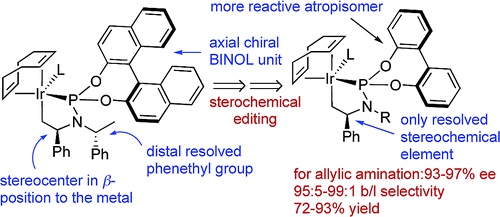A Simple Iridium Catalyst with a Single Resolved Stereocenter for Enantioselective Allylic Amination. Catalyst Selection from Mechanistic Analysis

A study of the relationship between the stereochemical elements of a phosphoramidite ligand and the stereoselectivity of iridium-catalyzed amination of allylic carbonates is reported. During catalyst activation, a complex of a phosphoramidite ligand possessing one axial chiral binaphtholate group and two resolved phenethyl substituents converts to a more reactive cyclometalated complex containing one distal chiral substituent at nitrogen, one substituent that becomes part of the metalacycle, and one unperturbed binaphtholate group. Systematic changes were made to the different stereochemical elements. Replacement of the distal chiral phenethyl substituent with a large achiral cycloalkyl group led to a catalyst that reacts with rates and enantioselectivities that are similar to those of the original catalyst with the phenethyl group. Studies of the reactions of diastereomeric ligands containing (R) or (S) binaphtholate groups on phosphorus, along with one (R)-phenethyl and one achiral cyclododecyl group on nitrogen, show that the complexes of the two diastereomeric ligands undergo cyclometalation at much different rates. To access both diastereomeric catalysts and to determine if the reaction can occur selectively with an even simpler ligand containing a phenethyl substituent at nitrogen as the only resolved stereochemical element, the catalyst derived from a phosphoramidite containing a biphenolate group was studied. Catalysts generated from this ligand were shown to react in all cases examined with nearly the same rates, regioselectivities, and enantioselectivities as catalysts derived from the original more elaborate ligand. The absolute stereochemistry of the product implies that the major enantiomer is formed from the (Ra,Rc)-atropisomer of the catalyst containing the biphenolate group.
Read more on publisher's site.